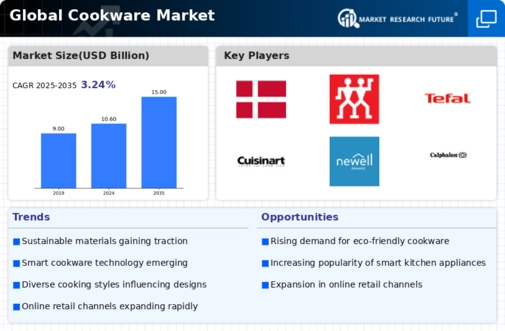Cookware Size
Cookware Market Growth Projections and Opportunities
In 2022, the cookware market was estimated to be worth USD 24.33 billion. According to projections, the cookware market industry will expand at a compound annual growth rate (CAGR) of 6.90% from USD 26.01 billion in 2023 to USD 44.35 billion by 2032. The primary market factors driving market expansion are millennia's preference for cooking at home and increased spending on home modifications and renovations.
The cookware market is influenced by a variety of market factors that shape its dynamics and trends. One key factor is consumer preferences and lifestyle changes. As people become more health-conscious and focused on home-cooked meals, there is a growing demand for cookware that supports healthier cooking methods such as non-stick and ceramic coatings. Additionally, the trend towards smaller households and busy lifestyles has increased the demand for convenient and time-saving cookware solutions, like instant pots and multi-functional cookware sets.
Economic factors also play a crucial role in the cookware market. Fluctuations in disposable income and overall economic conditions impact consumers' purchasing power. During economic downturns, consumers may opt for more budget-friendly cookware options, while during periods of economic growth, there may be an increased demand for premium and high-end cookware products. Moreover, global economic trends, such as trade policies and currency exchange rates, can affect the pricing and availability of raw materials, influencing the overall market landscape.
Innovation and technological advancements are significant market factors that drive competition and product development in the cookware industry. Manufacturers are constantly introducing new materials, designs, and features to meet the evolving needs of consumers. Advanced technologies, such as induction cooking, have also contributed to the development of cookware designed specifically for these cooking methods. The adoption of smart technologies, such as temperature sensors and connectivity features, is another trend that is reshaping the cookware market, offering consumers more control and precision in their cooking processes.
Environmental considerations have become increasingly important in the cookware market. With a growing awareness of sustainability and eco-friendly practices, consumers are seeking cookware made from environmentally friendly materials and produced through sustainable manufacturing processes. This has led to the rise of cookware brands that prioritize the use of recycled materials, minimize carbon footprints, and focus on environmentally responsible packaging.
Retail trends and distribution channels also impact the cookware market. The rise of e-commerce has significantly altered the way consumers purchase cookware, providing them with a wider range of options and the convenience of online shopping. Traditional brick-and-mortar retailers, on the other hand, continue to play a vital role, especially for consumers who prefer to physically inspect and feel the products before making a purchase. The balance between online and offline retail channels has become a critical factor for cookware manufacturers in reaching and satisfying their diverse customer base.
Government regulations and standards contribute to the shaping of the cookware market by ensuring product safety, quality, and compliance. Regulations related to food safety and the use of certain materials in cookware influence the manufacturing processes and materials chosen by industry players. Adherence to these standards is not only a legal requirement but also a crucial factor in building consumer trust and maintaining a positive brand image.















Leave a Comment